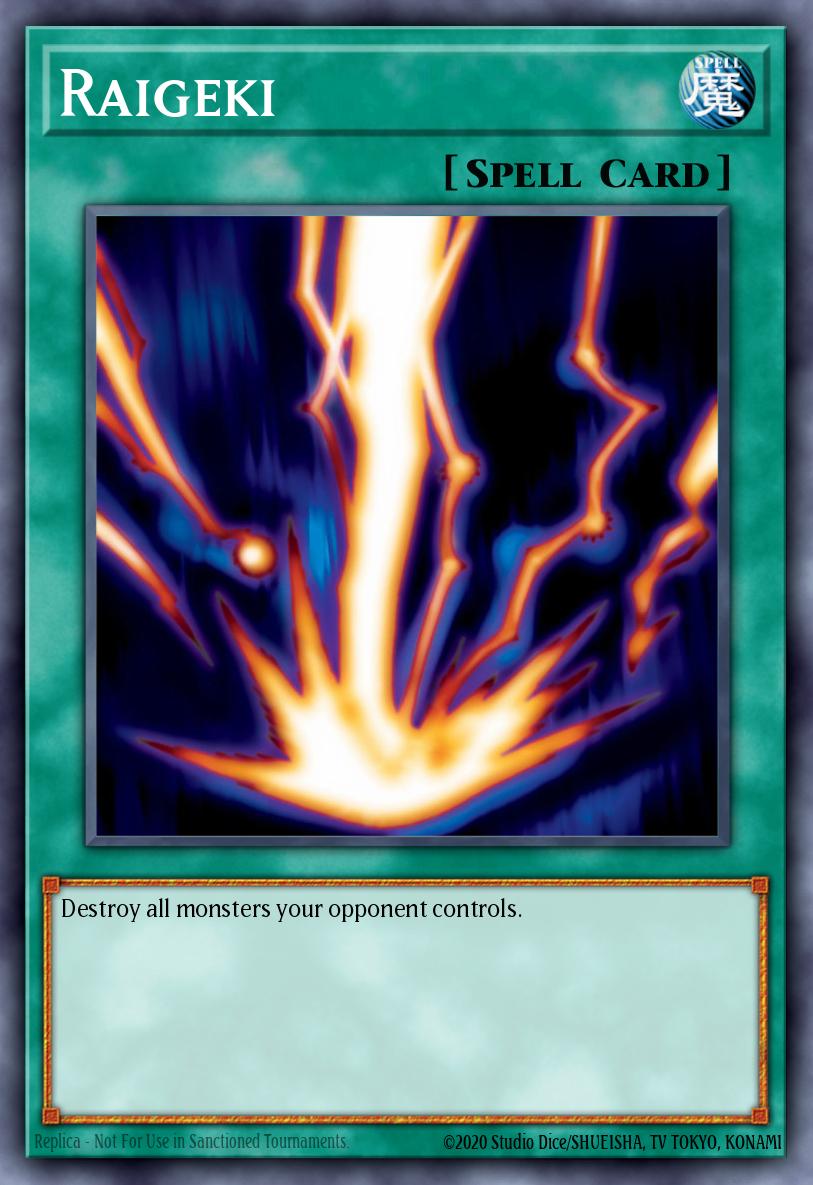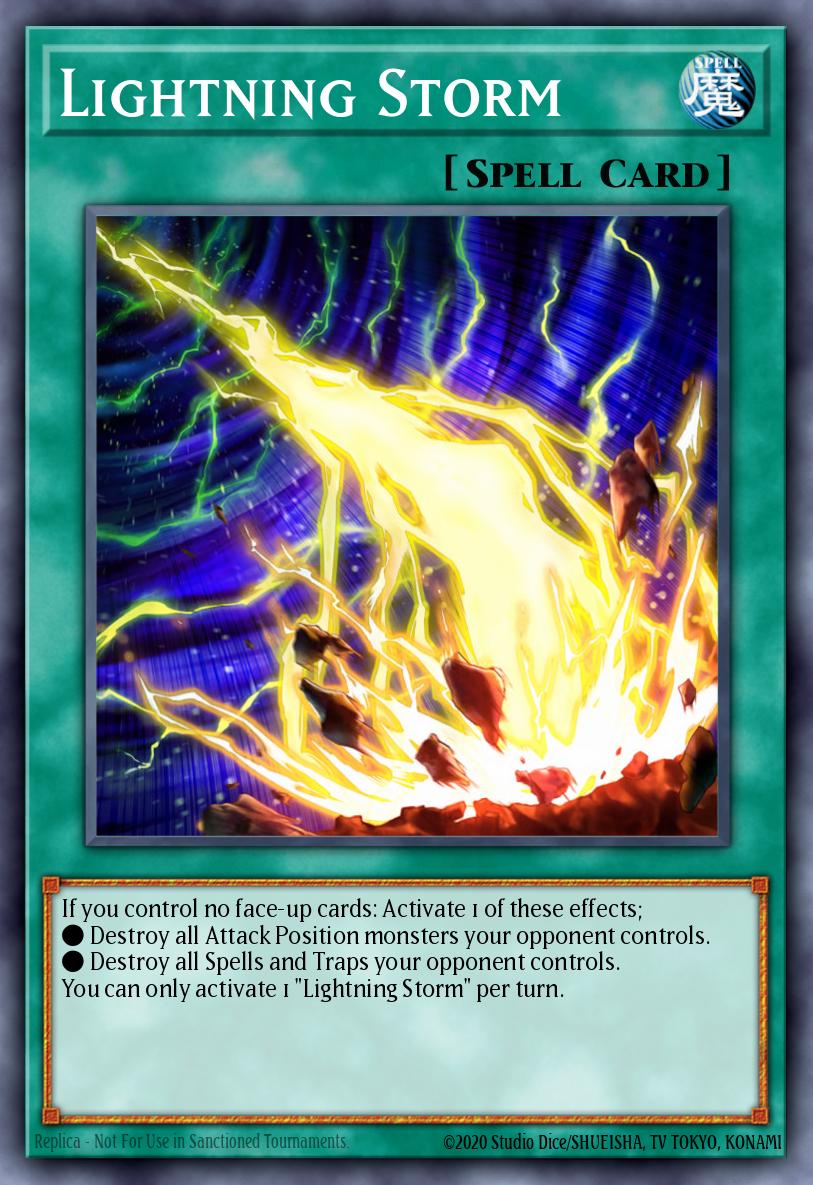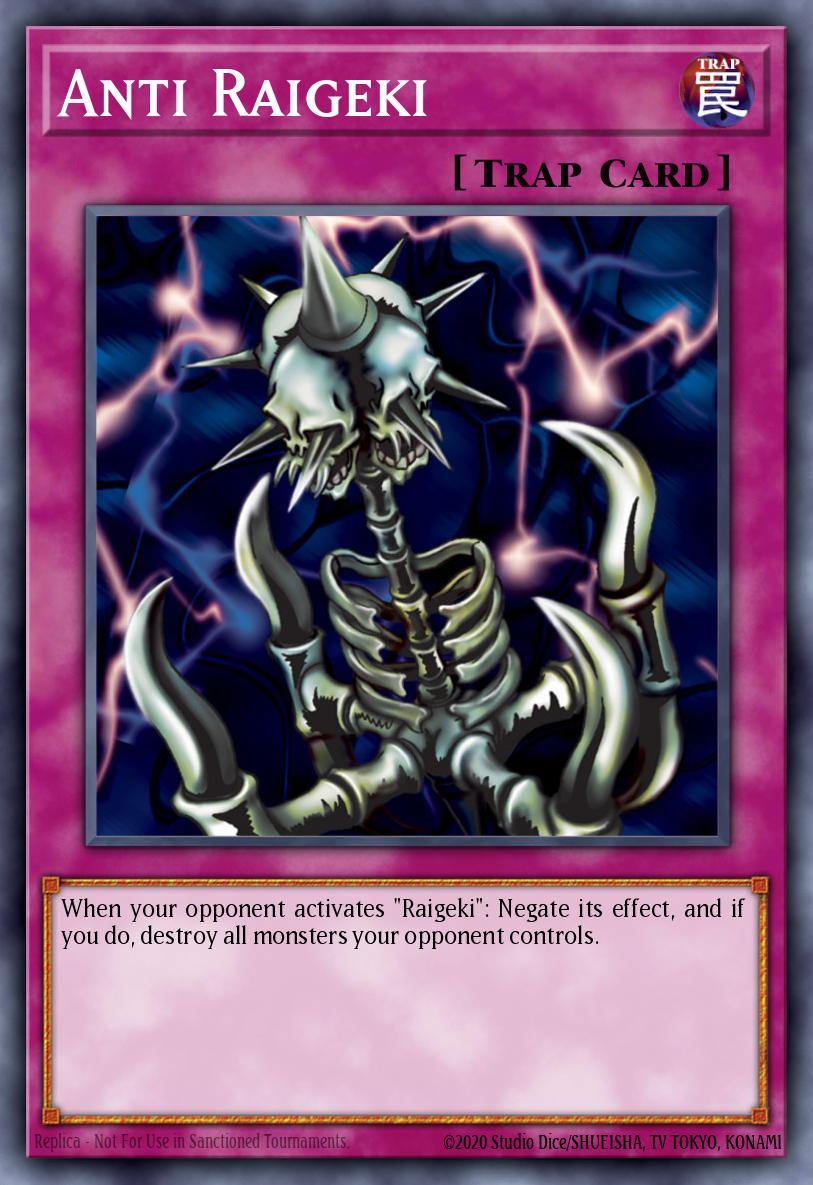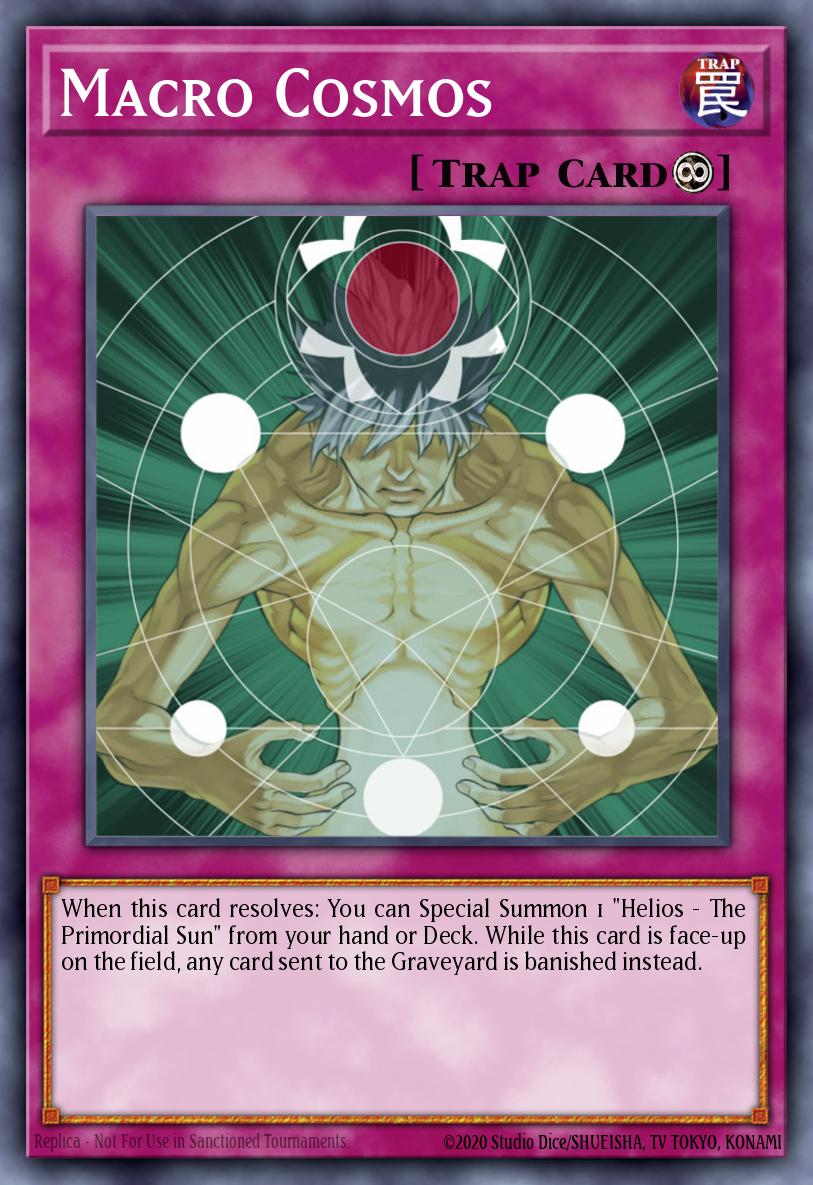Also read: Part 2: The Evolution of the Design
The Design of Yu-Gi-Oh 3: The Raigeki Economy
This is part 2 of a series about the game design of Yu-Gi-Oh. If you haven't checked the previous parts, they provide more context for what this article is about but aren't necessary reading to understand. Last part we discussed the origins of Yu-Gi-Oh and some of its initial mechanics - today we'll discuss how those mechanics evolved as the game went on.
Paragraph 1: The Raigeki Economy
 Raigeki is a very, very old and simple card. It simply reads: "Destroy all monsters your opponent controls". No cost, no restrictions, nothing. You just use Raigeki, it goes to the graveyard and the enemy loses all their monsters. In any other card game Raigeki would be absurdly strong; in Yu-Gi-Oh, it's considered a bad card.
Raigeki is a very, very old and simple card. It simply reads: "Destroy all monsters your opponent controls". No cost, no restrictions, nothing. You just use Raigeki, it goes to the graveyard and the enemy loses all their monsters. In any other card game Raigeki would be absurdly strong; in Yu-Gi-Oh, it's considered a bad card.
This is because of the Negate Economy. If the opponent has 3 negates on the field, for example, activating Raigeki would fetch one of the negates - you went 1 card in hand for 1 negate on the board. Not bad but also nothing special for a boardbreaker; any card could do that. However, cards like Dark Ruler No More or Dinowrestler Pankratops have much better negate economy, being able to deal with more than one negate at a time.
That isn't Raigeki's only issue, of course. The negate economy assumes all of the opponent's disruption is both in the form of negates and as monsters on the field, a type of board getting rarer by the day. If the opponent doesn't have spell/trap negate Raigeki gets better, but if their disruption is in the backrow it gets worse as they don't care as much against Raigeki. Lightning Storm ends up as a better boardbreaker than Raigeki because it can trade with both disruption in the backrow and in the monster zone, rendering Raigeki almost obsolete.
Paragraph 2: The Disruption Economy
 But of course, the Negate Economy isn't very true to real games - boards often aren't just of omni negates, not every card of yours fetches a negate and many other complications. Because of that, rather than thinking in terms of the Negate Economy, it's often better to think in terms of the Disruption Economy.
But of course, the Negate Economy isn't very true to real games - boards often aren't just of omni negates, not every card of yours fetches a negate and many other complications. Because of that, rather than thinking in terms of the Negate Economy, it's often better to think in terms of the Disruption Economy.
The Disruption Economy is very similar to the Negate Economy but more refined: The main difference here is we no longer assume the board is just negates, leading to more effective boardbreakers. For example, under the Negate Economy a board that set 5 backrow would assume it's 5 negates - ie, 5 Solemn Judgments. In truth, however, it's likely a combination of Solemns with non-omni negate traps like Infinite Impermanence or Ice Dragon's Prison, cards that can't deal with Lightning Storm. This means that, against that board, you'd spend 1 card advantage (Lightning Storm) to trade with 5 of their disruptions, profiting +4.
Important note - disruption often doesn't correspond 1-to-1 with card advantage. If you use Mystical Space Typhoon on an unknown backrow and it turns to be a bluff set and not a disruption trapb then while you did go 0 in card advantage you didn't profit in the Disruption Economy; you spend 1 card and didn't remove any of the opponent's disruptions. You went -1 on the disruption economy.
Similarly, sometimes you can go plus in disruption economy while going minus in advantage. This is the case with the Kaijus like Gameciel, the Sea Turtle Kaiju. You and your opponent both lose a card but the opponent gains Gameciel, it's a -1 for you in card advantage. If the monster you tributed to summon your Kaiju had a negate attached to it, however, it then becomes a 0 in the Disruption Economy. However, if the board on the field was I:P Masquerena and Lib the World Key Blademaster the situation changes considerably: Kaiju'ing the I:P before it uses its effect is a +1 to the disruption economy; you spent 1 card to remove 2 of the opponent's disruptions, the floating off Lib and the Knightmare Unicorn that would have been summoned off Masquerena. This is a great example of how, depending on the board, the disruption economy may change the value of your boardbreakers.
Paragraph 3: The Case With Floodgates
 There is a type of disruption that doesn't fall into this model, however - Floodgates. Cards like Skill Drain and Rivalry of Warlords stand on a weird spot where their disruption value can change between 0, 1 and, believe it or not, infinite.
There is a type of disruption that doesn't fall into this model, however - Floodgates. Cards like Skill Drain and Rivalry of Warlords stand on a weird spot where their disruption value can change between 0, 1 and, believe it or not, infinite.
A floodgate's disruption value is 0 when the opposing deck doesn't care about the floodgate - Skill Drain vs Eldlich or Macro Cosmos vs Floowandereeze, for example. The deck doesn't care about the floodgate and thus doesn't have to spend any resource getting it off the field. Often these decks will even keep the opponent's floodgate until the end of the game, even.
Meanwhile a floodgate can be valued 1 disruption when the opposing deck can't full combo against the floodgate but still can deal with it; for example, flipping a floodgate and having it be sniped by MST would mean that floodgate was worth 1 disruption in the disruption economy. That's all fine and dandy but that's not the full story behind floodgates - and it's also not its full potential, either.
The floodgate's true power appears when the opponent's deck didn't draw any generic out to it and cannot play through it. Under this situation the disruption power of the floodgate is essentially infinite: No matter how many extenders and combo starters the opponent has in their hand they will not be able to play through the floodgate and the game is essentially over. The power of disruption was infinite, and you won the game.
This is also why Konami likes to print floodgates when doing 1-of support cards for legacy decks, like with the infamous Ghost Meets Girl - A Masterful Mayakashi Shiranui Saga; old decks often can't put enough disruptions - they can put one or two but that's not nearly enough to compete with the meta that often puts three or four with followup for next turn. Printing a floodgate means that, now they have a shot at competing in the disruption economy. If you can only make one new card to make an older deck be rogue, making the deck go from putting 1 or 2 disruptions to several is very hard or even impossible. Meanwhile, making the new card be a floodgate has much better odds at making the deck viable.
Conclusion
 Disruption is the bread and butter of modern YGO, be it for keeping yourself alive or pushing through them to go for lethal. Practically every deck runs them and can play through them; it's impossible to play without running across them. Keeping in mind the disruption economy can seriously help level up your gameplay - it helps you better decide how to break the opponent's board, how to evaluate end boards and even as a new framework to see card advantage in.
Disruption is the bread and butter of modern YGO, be it for keeping yourself alive or pushing through them to go for lethal. Practically every deck runs them and can play through them; it's impossible to play without running across them. Keeping in mind the disruption economy can seriously help level up your gameplay - it helps you better decide how to break the opponent's board, how to evaluate end boards and even as a new framework to see card advantage in.
However this is not all that modern YGO is - there is another part to it, Popping Off - that is, what you do after all the disruption has been cleared and you got your combo. What are the design implication of lethal lines? Disruption lines? What if you get interrupted while popping off? What even is popping off?
Those and more questions to be answered - in part 4. See you then.




